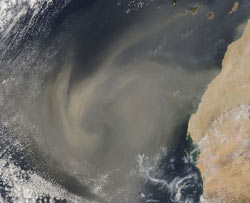Staying Active with Asthma
In celebration of Asthma Awareness Month, I thought it would be fun to talk with a student who has asthma herself. I interviewed Shannyn, an energetic 10 year-old who taught me all about what it is like to have asthma. Shannyn let me know that she doesn’t let asthma get in the way of her active lifestyle and love of playing outdoors with her sisters and friends. At around age 3, Shannyn experienced her first asthma attack. She explained to me that an asthma attack is an episode, accompanied by wheezing and coughing, which makes it very difficult to breathe. Triggers, such as dust, chemicals and seasonal allergies, are things that can provoke the event of an asthma attack. Lucky enough for this smart girl, she knows to avoid these triggers by staying away from heavy bathroom cleaners and helping her mom to clean the house of dust.
Asthma doesn’t get in the way of Shannyn’s busy lifestyle. Her love of running club, tumbling, soccer, kickball and playing in the pool are what keep Shannyn going. By taking a daily preventative inhaler, she is able to participate in these sports and after school activities. Shannyn is careful to also carry her rescue inhaler with her when going for runs, in case this physical activity makes her asthma worse. She let me know that although her asthma can sometimes make it hard to keep up with others when running, that she has a few good friends that will run at a steady pace with her. I am impressed with all the fun, physical activities this girl does! When telling me about how she is teaching one of her friends how to do a kart wheel, I asked if she could teach me. At age 22, I still haven’t picked up how to do a kart-wheel.
It’s no secret that Shannyn doesn’t let her asthma define how she spends her time and what kinds of activities she does. By knowing which triggers to avoid, taking the proper medication, and doing routine activities like running club to control her asthma, Shannyn is able to live a very spirited life. She is looking forward to the summer, where she is planning to spend lots of time swimming in the pool with her two sisters. She has even started to plan her next birthday party, where she and friends will have a spa day. Shannyn let me know that asthma doesn’t get in the way of staying active and having fun with friends and family. She is a role model to people of all ages who have asthma.
Shelby Egan was an extern in the EPA’s Air and Radiation Division in Region 5. She is currently obtaining her Master’s degree in Urban Planning and Policy at the University of Illinois at Chicago. She has a passion for protecting natural resources, cities she’s never been to and cooking any recipe by The Pioneer Woman.



 Every summer, particles of dust from the Sahara Desert travel halfway around the globe and settle in the Caribbean area around Puerto Rico. This dust impacts not only our air quality, but the climate. This cloud, full of minerals and fungi, alters the quality of air and impacts not only respiratory health, but ecosystems as well. Some studies trace the loss of coral reefs in the Caribbean to this phenomenon. It’s incredible that these small particles from the Sahara Desert in Africa can cause so many adverse impacts to the environment and health an ocean away.
Every summer, particles of dust from the Sahara Desert travel halfway around the globe and settle in the Caribbean area around Puerto Rico. This dust impacts not only our air quality, but the climate. This cloud, full of minerals and fungi, alters the quality of air and impacts not only respiratory health, but ecosystems as well. Some studies trace the loss of coral reefs in the Caribbean to this phenomenon. It’s incredible that these small particles from the Sahara Desert in Africa can cause so many adverse impacts to the environment and health an ocean away. Todos los veranos las partículas de polvo del Desierto del Sahara viajan alrededor del mundo y se asientan en el área del Caribe, especialmente en Puerto Rico. Este polvo no solo afecta nuestra calidad de aire, pero también el clima. La nube, lleva de minerales y hongos, altera la calidad del aire e impacta severamente a aquellos con condiciones respiratorias, pero también afecta los ecosistemas. Inclusive algunos estudios asocian la pérdida de corales en el Caribe a este fenómeno. Es increíble que partículas tan pequeñas sean responsables de tanto impactos adversos al medioambiente, las personas y a los ecosistemas que se encuentran a un océano de por medio.
Todos los veranos las partículas de polvo del Desierto del Sahara viajan alrededor del mundo y se asientan en el área del Caribe, especialmente en Puerto Rico. Este polvo no solo afecta nuestra calidad de aire, pero también el clima. La nube, lleva de minerales y hongos, altera la calidad del aire e impacta severamente a aquellos con condiciones respiratorias, pero también afecta los ecosistemas. Inclusive algunos estudios asocian la pérdida de corales en el Caribe a este fenómeno. Es increíble que partículas tan pequeñas sean responsables de tanto impactos adversos al medioambiente, las personas y a los ecosistemas que se encuentran a un océano de por medio.